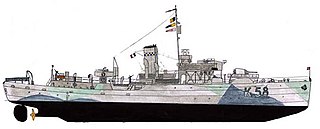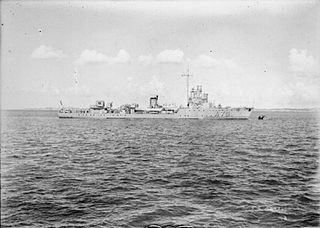 La Capricieuse | |
| History | |
|---|---|
| Name: | La Capricieuse |
| Builder: | Chantiers Dubigeon |
| Launched: | 19 April 1939 |
| Fate: | Scrapped, September 1964 |
| General characteristics | |
| Class and type: | Elan-class aviso |
| Displacement: |
|
| Length: | |
| Beam: | 8.70 m (28 ft 7 in) [1] |
| Draught: | 3.28 m (10 ft 9 in) [1] |
| Propulsion: | 2 × Sulzer marine diesel engines, 4,600 hp (3,430 kW), 2 shafts [1] |
| Speed: | 20 knots (37 km/h; 23 mph) [1] |
| Range: |
|
| Armament: |
|
La Capricieuse was a ship of the French Elan-class minesweeping sloops (Avisos dragueur de mines). She was built by Chantiers Dubigeon at Nantes and launched on 19 April 1939. [2]

Chantiers Dubigeon was a shipyard established in 1760 by Julien Dubigeon in Nantes, France. In 1916 the heirs of Adolphe Dubigeon disagreed how to dispose of the company. Part of it was sold to Chantiers de la Loire and the rest was reorganized into the Anciens Chantiers Dubigeon which build a new yard on the Île de Nantes. In 1963 it was combined with La société Loire-Normandie, forming the Groupe Dubigeon-Normandie which was renamed Dubigeon-Normandie SA in 1969. It was acquired by Alsthom Atlantique in 1983, which closed the last shipyard in Nantes in 1987.

Nantes is a city in Loire-Atlantique on the Loire, 50 km (31 mi) from the Atlantic coast. The city is the sixth-largest in France, with a population of 303,382 in Nantes and a metropolitan area of nearly 950,000 inhabitants. With Saint-Nazaire, a seaport on the Loire estuary, Nantes forms the main north-western French metropolis.
After the Fall of France she was at Portsmouth and on 3 July 1940 she was seized by the Royal Navy. [2] She served in the Royal Navy as HMS La Capricieuse until June 1945 when she was restored to the French Navy. [2] She continued in service after the war and was scrapped in September 1964. [2]

Portsmouth is a port city in Hampshire, England, with a total population of 205,400 residents. The city of Portsmouth is nicknamed Pompey and is mainly built on Portsea Island, a flat, low-lying island measuring 24 square kilometres in area, just off the south-east coast of Hampshire. Portsmouth is the only island city in the United Kingdom, and is the only city whose population density exceeds that of London.

The Royal Navy (RN) is the United Kingdom's naval warfare force. Although warships were used by the English kings from the early medieval period, the first major maritime engagements were fought in the Hundred Years' War against the Kingdom of France. The modern Royal Navy traces its origins to the early 16th century; the oldest of the UK's armed services, it is known as the Senior Service.

The French Navy, informally "La Royale", is the maritime arm of the French Armed Forces. Dating back to 1624, the French Navy is one of the world's oldest naval forces. It has participated in conflicts around the globe and played a key part in establishing the French colonial empire.









